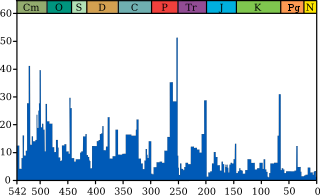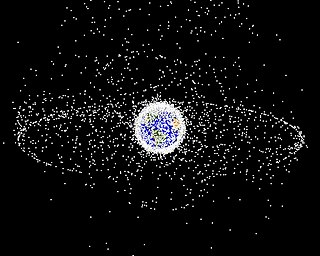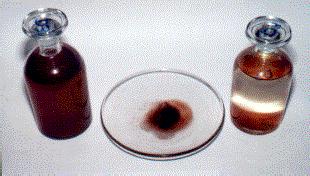 W
WThe clathrate gun hypothesis is a proposed explanation for the periods of rapid warming during the Quaternary. The idea is that changes in fluxes in upper intermediate waters in the ocean caused temperature fluctuations that alternately accumulated and occasionally released methane clathrate on upper continental slopes, these events would have caused the Bond Cycles and individual interstadial events, such as the Dansgaard–Oeschger interstadials.
 W
WThe Cretaceous–Paleogene (K–Pg) extinction event was a sudden mass extinction of three-quarters of the plant and animal species on Earth, approximately 66 million years ago. With the exception of some ectothermic species such as sea turtles and crocodilians, no tetrapods weighing more than 25 kilograms survived. It marked the end of the Cretaceous period, and with it the Mesozoic Era, while heralding the beginning of the Cenozoic Era, which continues to this day.
 W
WAn extinction event is a widespread and rapid decrease in the biodiversity on Earth. Such an event is identified by a sharp change in the diversity and abundance of multicellular organisms. It occurs when the rate of extinction increases with respect to the rate of speciation. The number of major mass extinctions in the last 440 million years are estimated from as few as five to more than twenty. These differences stem from disagreement as to what constitutes an extinction event as "major", and the data chosen to measure past diversity.
 W
WThe Gaia hypothesis, also known as the Gaia theory, Gaia paradigm, or the Gaia principle, proposes that living organisms interact with their inorganic surroundings on Earth to form a synergistic and self-regulating, complex system that helps to maintain and perpetuate the conditions for life on the planet.
 W
WThe Great Oxidation Event (GOE), also called the Great Oxygenation Event, was a time period when the Earth's atmosphere and the shallow ocean first experienced a rise in the amount of oxygen. This occurred approximately 2.4–2.0 Ga (billion years ago), during the Paleoproterozoic era. Geological, isotopic, and chemical evidence suggests that biologically-produced molecular oxygen (dioxygen, O2) started to accumulate in Earth's atmosphere and changed it from a weakly reducing atmosphere practically free of oxygen into an oxidizing atmosphere containing abundant oxygen, causing many existing anaerobic species on Earth to die out. The event is inferred to have been caused by cyanobacteria producing the oxygen, which stored enough chemical energy to enable the subsequent development of multicellular life-forms.
 W
WThe Kessler syndrome, proposed by NASA scientist Donald J. Kessler in 1978, is a scenario in which the density of objects in low Earth orbit (LEO) due to space pollution is high enough that collisions between objects could cause a cascade in which each collision generates space debris that increases the likelihood of further collisions. In 2009 Kessler wrote that modeling results had concluded that the debris environment was already unstable, "such that any attempt to achieve a growth-free small debris environment by eliminating sources of past debris will likely fail because fragments from future collisions will be generated faster than atmospheric drag will remove them". One implication is that the distribution of debris in orbit could render space activities and the use of satellites in specific orbital ranges difficult for many generations.
 W
WThe Permian–Triassic extinction event, also known as the End-Permian Extinction and colloquially as the Great Dying, formed the boundary between the Permian and Triassic geologic periods, as well as between the Paleozoic and Mesozoic eras, approximately 251.9 million years ago. It is the Earth's most severe known extinction event, with the extinction of 57% of biological families, 83% of genera, 81% of marine species and 70% of terrestrial vertebrate species. It was the largest known mass extinction of insects.
 W
WThe Kerala red rain phenomenon was a blood rain event that occurred in Wayanad district region of Malabar on Monday, 15 July 1957 and the colour subsequently turned yellow and also 25 July to 23 September 2001, when heavy downpours of red-coloured rain fell sporadically on the southern Indian state of Kerala, staining clothes pink. Yellow, green and black rain was also reported. Coloured rain was also reported in Kerala in 1896 and several times since, most recently in June 2012, and from 15 November 2012 to 27 December 2012 in eastern and north-central provinces of Sri Lanka.